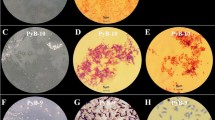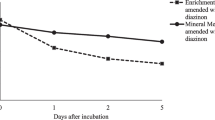Abstract
Several strains from tributyl phosphate (TBP)-polluted soils were isolated and screened for their ability to degraded this widely used organophosphorus compound. The most active strain, identified as Serratia odorifera, degrades up to 600 μm TBP (initially present in the medium at 2 mm) during its growth phase, within 8 h from inoculation. However, this bacterium could not utilize TBP as the sole carbon and/or phosphorus source but nevertheless is a good candidate for bioremediation of TBP-polluted industrial sites.
Similar content being viewed by others
References
EPA (1992) Chemical information collection and data development tributyl phosphate test results. www.epa.gov/oppt/ chemtest/tributph.htm
Harper LL, McDaniel CS, Miller CE, Wild JR (1988) Dissimilar plasmids isolated from Pseudomonas diminuta MG and a Flavobacterium sp. (ATCC 27551) contain identical opd genes. Appl. Environ. Microbiol. 54: 2586-2589.
Kumar S, Mukerji KG, Lal R (1996) Molecular aspects of pesticide degradation by microorganisms. Crit. Rev. Microbiol. 22: 1-26.
Muller JP, Cojean J, Gentil R (1994) Process for determining tributyl phosphate and/or butanol by liquid-phase chromatography. European Patent Application EP0578579.
Nakamura A (1991) Tri-n-butyl phosphate. Monograph of International Program on Chemical Safety, EHC 112. www.inchem.org/documents/ehc/ehc/ehc112.htm
Owen S, Jeong BC, Poole PS, Macaskie LE (1992) Tributyl phosphate degradation by immobilized cells of a Citrobacter sp. Appl. Biochem. Biotechnol. 34/35: 693-707.
Pierpoint WS (1957) The phosphatase and metaphosphatase activities of pea extract. Biochem. J. 65: 67-76.
Raushel FM (2002). Bacterial detoxification of organophosphate nerve agents. Curr. Opin. Microbiol. 5: 288-295.
Rosenberg A, Alexander M (1979) Microbial cleavage of various organophosphorus insecticides. Appl. Environ. Microbiol. 37: 886-891.
Sasaki K, Suzuki T, Takeda M, Uchiyama M (1984) Metabolism of phosphoric acid triesters by rat liver homogenate. Bull. Environ. Contam. Toxicol. 33: 281-288.
Stoner D, Tien A (1995) Method and compositions for the degradation of tributyl phosphate in chemical waste mixtures US Patent 5453375.
Thomas RA, Macaskie LE (1998) The effect of growth conditions on the biodegradation of tributyl phosphate and potential for the remediation of acid mine drainage waters by a naturallyoccurring mixed microbial culture. Appl. Microbiol. Biotechnol. 49: 202-209.
Thomas RAP, Macaskie LE (1996) Biodegradation of tributyl phosphate by natural occuring microbial isolates and coupling to the removal of uranium from aqueous solution. Environ. Sci. Biotechnol. 30: 2371-2375.
Thomas RAP, Greated A, Lawlor K, Bailey M, Macaskie LE (1997a) Stabilisation of tributyl phosphate-biodegradative ability of natural-occuring Pseudomonas using ampicillin. Biotechnol. Tech. 11: 781-785.
Thomas RAP, Morby AP, Macaskie LE (1997b) The biodegradation of tributyl phosphate by naturally occurring microbial isolates. FEMS Microbiol. Lett. 155: 155-159.
Weisburg WG, Barns SM, Pelletier DA, Lane DJ (1991) 16S ribosomal DNA amplification for phylogenetic study. J. Bacteriol. 173: 697-703.
Author information
Authors and Affiliations
Rights and permissions
About this article
Cite this article
Berne, C., Montjarret, B., Guountti, Y. et al. Tributyl phosphate degradation by Serratia odorifera . Biotechnology Letters 26, 681–686 (2004). https://doi.org/10.1023/B:BILE.0000023030.69207.c0
Issue Date:
DOI: https://doi.org/10.1023/B:BILE.0000023030.69207.c0




